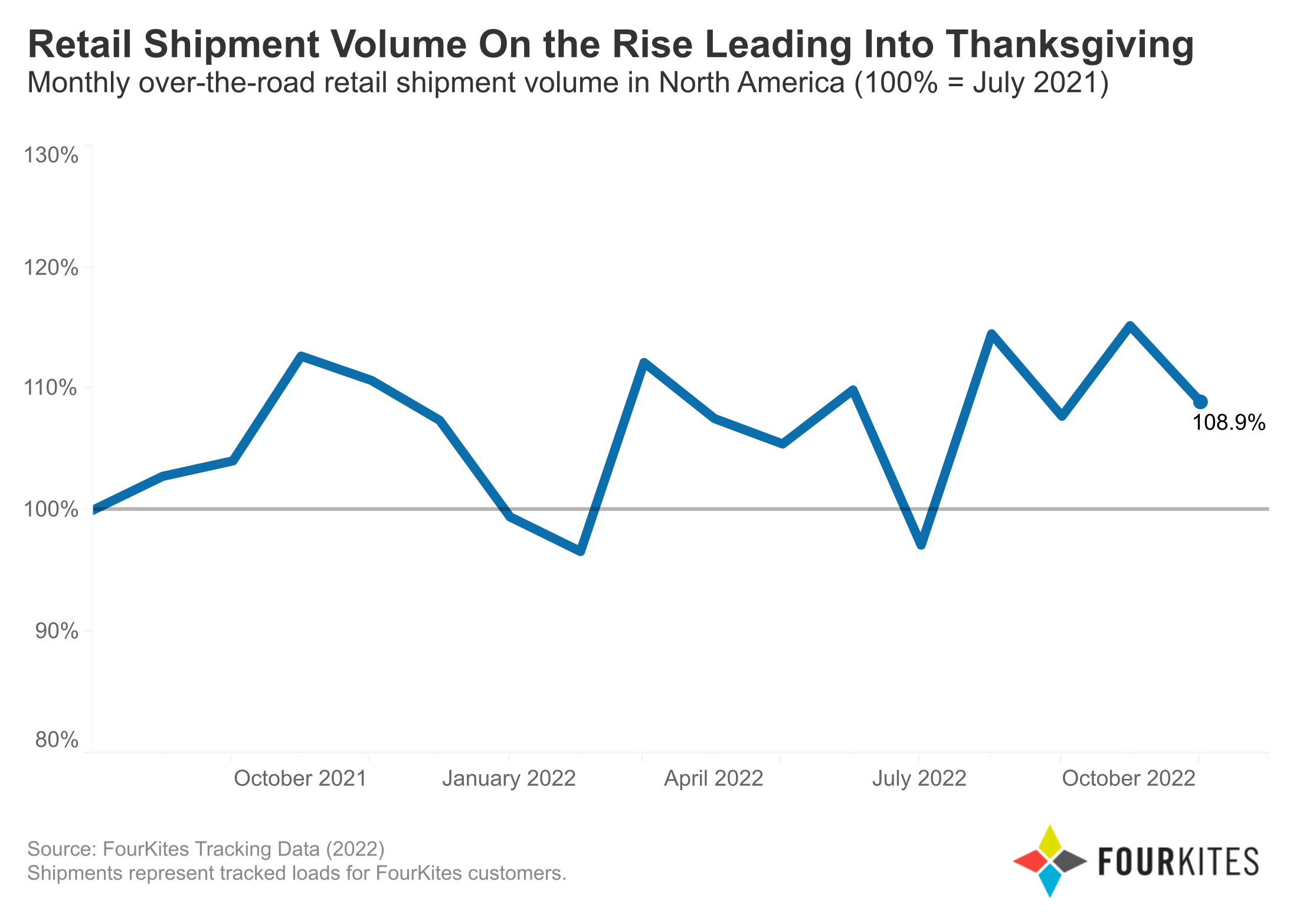
The holiday season is a busy and critical time for retailers. While consumer purchases are up due to the holiday season, the retailers are trying to juggle products and time-sensitive promotions with supply chain disruptions that continue to plague us post-Covid.
According to NRF, 196.7 million Americans shopped in stores and online during the five-day holiday shopping period from Thanksgiving Day through Cyber Monday – nearly 17 million from 2021 and the highest figure since NRF first started tracking this data in 2017.
With so much attention on inflation, this is a bit of a surprise for many. But once you dig into the numbers you’ll find that discounting also set record highs. For example, electronics discounts averaged 25% versus only 8% in 2021.
“Leading up to the flurry of holiday shopping, FourKites data shows that retail shipment volumes were a bit lumpier compared to the slow-and-steady increase you typically see for peak season,” said Mark Delaney, FourKites VP, Industry Strategy, Retail & CPG. “Excess inventory, a fear of shipping delays creating safety stock orders and extended sales promotions collided to create atypical shipping patterns.”


The holiday season is a must win time for retailers. Having product in stores on time is imperative. This becomes especially difficult when there are numerous delays and disruptions affecting retailers’ supply chain.

The pandemic eroded customer loyalty with retailers. Customer loyalty is now up for grabs and customer expectations around proactive communication, on-time delivery and sustainability have never been higher.

Constantly shifting consumer behavior and a preference for curbside has prompted suppliers to create micro-fulfillment centers (MFC’s). Because MFC’s are small, they are easily customized to the needs of a specific retailer or customer base, but many are still waiting for a proven return on investment and what will work best with their workflows.

Gloomy economic forecasts, accumulating delays and ocean shipping rates are key disruptions that are on retailers’ minds. While some ended up with excess inventory in Q4, one needs to be prepared for any last minute holiday rushes that may pop up.

Retailers have been dealing with labor constraints throughout the pandemic and experts agree that they are not going away anytime soon. The cost of employee churn is high for retailers – retention rates are down, which pushes costs up to acquire new staff, impacting margins. It is difficult to serve customers or solve delivery issues if you don’t have the staff to do so.
Many retailers utilize technology, such as a real-time visibility solution, to provide automation and efficiency to their supply chain operations, but not all visibility solutions are created equal. Just because a retailer has purchased or implemented a visibility solution does not mean that they have the quality and amount of data to have actionable results. A real-time visibility solution should go beyond the typical track-and-trace workflow to provide the automation and digitization that retailers require.
The supply chain is made of multiple interconnected modes and a visibility solution should be too. By having an end-to-end visibility solution that connects each leg of a multimodal journey, you get a seamless visibility to know exactly where your product is throughout the journey, whether it is traveling to individual stores or centralized distribution centers.
One of Ace’s goals for our logistics revolution is getting more deliveries to our stores to allow them to fulfill more specific customer requests. With FourKites, because the stores have greater visibility on those additional shipments, not only are they getting that product quicker for their customers, but stores are able to schedule their labor even better now as well.
Having a single platform with all the data and information in one place is critical. During the holiday season, associates or customer service representatives cannot spend time going back and forth manual processes or multiple systems. Connect all of your systems, including OMS, YMS or TMS, with a real-time visibility solution so all of your internal stakeholders have the right data in one place.
In the past we would have had to dig into PO numbers or truck numbers. It was just much more challenging. Now it’s just one-stop. We can see everything that’s moving in a single picture, within the FourKites dashboard.
Ensure orders are delivered on time and in full and eliminate risks of stockouts this holiday season. Drill down in terms of your visibility to individual SKUs or PO’s and keep delivery on track by alerting internal and external stakeholders— from supply planners to store operations to customer service—of potential disruptions or discrepancies between the actual vs. planned order quantity.
In the past we would have had to dig into PO numbers or truck numbers. It was just much more challenging. Now it’s just one-stop. We can see everything that’s moving in a single picture, within the FourKites dashboard.
Inaccurate or incomplete ETAs can disrupt your operations, planning and customer satisfaction. Your real-time visibility solution should include machine learning and AI and quality data to have the most accurate and complete ETAs. This can translate to better yard management, operations and demand planning, product availability and customer satisfaction this holiday season. This also allows for more effective workforce management which better leverages the scarce labor.
The old process, prior to FourKites, was literally a group of associates thinking that the truck was going to arrive, waiting for the arrival. The time comes, the truck’s not there, what should we do now?
They’re not able to commit to a task that actually adds value to the store so that they can capitalize on the labor that they have. With FourKites visibility, these push notifications actually let them know six-, four-, two-, and one-hour updated ETA’s for the deliveries. So they’re able to allocate resources within the four walls more effectively.
With supply chain disruptions happening on a regular basis, it is inevitable that they should continue during the critical holiday season. Delayed inventory can ruin the outcomes of time-sensitive promotions and stores’ bottom line. Using real-time visibility allows supply chain managers to identify shipments that are (or at risk of being) delayed and proactively manage those exceptions to reduce dwell, operational inefficiencies, and product stockouts.
Everyone in the industry is looking for ways to mitigate disruptions caused by COVID-19. Some companies are leveraging their logistics partnerships, technology partners, I think often looking for internal stakeholders to help them identify ways to overcome many of these challenges. It takes time and effort to do so. But in the long run, I think many of us are looking at increasing the leverage of our data, trying to understand with our data, what can we do differently and really try and develop some actions that we need to take to overcome some of those things that were being experienced right now.
To receive a copy of the full checklist on how retailers’ can survive the holiday season with real-time visibility, click here.